What is That Critter and Why is It In My Home?
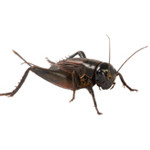 WHAT ARE CRICKETS?
WHAT ARE CRICKETS?
Crickets tend to be nocturnal and are generally characterized by slightly flattened looking, light brown to dark brown colored bodies and long antennae. Only the male cricket can “chirp” and does so by rubbing its hind legs against a forewing with between 50 to 300 ribs on it.
WHY DO I HAVE THEM?
When the outside air temperature begins to drop, crickets begin to look for a place to shelter from the winter weather and it’s then that you’ll find them moving into buildings and properties where they have everything they require: food, warmth, moisture and shelter. They are scavengers and their diet consists primarily of organic materials and may also include decaying plant matter and small seedlings. Once they begin to occupy a property, they may damage clothing, fabric (cotton, wool, silk, & synthetic blends), furniture coverings, curtains and even wallpaper.
ARE THEY DANGEROUS?
Although they can bite, it is rare for a cricket’s mouthparts to actually puncture the skin. Crickets do carry a significant number of diseases which, although having the ability to cause painful sores, are not fatal to humans. These numerous diseases can be spread through their bite, physical contact or their feces.
HOW DO I GET RID OF CRICKETS?
Getting rid of crickets in Washington D.C requires a two-pronged approach. Crickets primarily live outside, so it is essential that along with taking care of any infestation inside your home or property, the exterior is inspected for cricket harborages. This can be a tough task and requires a skilled, experienced pest management professional to seek out the many possible sources of infestation.
HOW CAN I PREVENT THIS IN THE FUTURE?
Preventing crickets is a very difficult task. However, making sure all cracks, crevices and holes are filled or sealed in and around basements, siding, doors and windows will make it much more difficult for the cricket to enter, infest and damage your property.
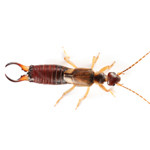 WHAT IS AN EARWIG?
WHAT IS AN EARWIG?
While you may know them as a “pincher bug”, earwigs are an insect easily recognized by their long, smooth bodies and pair of appendages at the tip of their abdomen called “cerci”.
WHY DO I HAVE THEM?
Earwigs are typically outdoor insects and are found in damp areas. They will, however, migrate indoors (often by accident) if the temperature climbs or if there is a lack of moisture present. As nocturnal insects, they normally congregate in areas that are dark and humid during the day. Typical indoor hiding places are under rugs or potted plants, in stacks of newspapers and similar locations. During the night they will come out to feed on decaying plant material as well as other insects, including fleas and mites. Occasionally, earwigs may be brought inside with the morning newspaper, lawn furniture, or other outside items that they were resting beneath.
ARE THEY DANGEROUS?
Earwigs may try to pinch if they feel threatened, but generally they are not considered to be dangerous to people or pets. Although they may wander indoors, it is a widely accepted thought that earwigs are an “occasional invader” and that they are nothing more than a nuisance pest.
HOW DO I GET RID OF EARWIGS?
Reducing moisture in and around your structure will help deter earwigs from entering your home or business.
HOW CAN I PREVENT THIS IN THE FUTURE?
Consider swapping out your regular fluorescent lights with sodium vapor yellow lights (bug lights), as they are less appealing to earwigs and other insects that are attracted to light. Lowering the humidity and eliminating moisture may also help control earwigs, but if your property has already been infested by these insects, your first call should be to your pest control company.
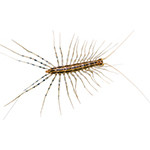 WHAT ARE HOUSE CENTIPEDES?
WHAT ARE HOUSE CENTIPEDES?
House centipedes are not an insect, but a common arthropod relative. They are easily recognizable due to their many legs. House centipedes are nocturnal creatures that live mainly outdoors, but may come inside.
WHY DO I HAVE THEM?
They live in damp places, such as rotting logs, under stones, in trash, mulch, clippings and can find conditions indoors like moist basements or closets that mimic their natural environment. Sometimes they will migrate indoors to find a warm moist shelter.
ARE THEY DANGEROUS?
Although a centipede bite can be painful, there are no long-lasting health effects.
HOW DO I GET RID OF HOUSE CENTIPEDES?
Your local pest company is the best option because they are predacious and feed on other small creatures, it will help to keep populations of insects that may serve as a food source at low levels, something our pest control professionals are trained to do. It will also help to remove harborage by closing up cracks and other openings that may provide a place to hide. Reduction of moisture is also useful as they thrive in cool damp locations.
HOW CAN I PREVENT THIS IN THE FUTURE?
Preventing house centipedes is a very difficult task as your property provides so many ideal sheltering conditions that appeal to these insects. Cleaning up your property to remove dead or rotting logs, removing mulch or lawn clippings as well as taking care of your trash will make your property less attractive to house centipedes.
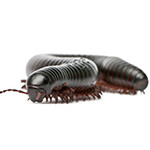 WHAT ARE MILLIPEDES?
WHAT ARE MILLIPEDES?
Millipedes are not actually insects, but rather arthropods. Millipedes are typically brown or black in color and tend to range from 1 to 2 inches in length, but some may grow larger. They do not have a thousand legs, like their name suggests, but actually have somewhere between 60 and 400. A millipede has much shorter legs than a centipede and a millipede cannot move very fast despite the number of legs they have.
WHY DO I HAVE THEM?
Most millipedes feed on damp and decaying vegetation and leaf litter. They spend most of their lives in the soil, but may also overwinter in leaf litter and debris found under trees. Occasionally, millipedes will make their way from their moist living conditions into homes, but will typically die because of lack of moisture and food. Millipedes are also attracted to light and may be found in large numbers around patios, driveways, decks and commercial buildings and in parking lots.
ARE THEY DANGEROUS?
Millipedes are not poisonous and do not bite or sting. They can emit a horrible fluid in order to defend themselves. Some species of millipede can spray this fluid several inches. The fluid can cause skin irritation in some people and should be washed off right away. Additionally, it may take some extra scrubbing to get rid of the odor.
HOW DO I GET RID OF MILLIPEDES?
Millipedes can be difficult to get rid of, especially if they enter your home in large numbers. A professional pest company is the best option, as DIY solutions usually do not suffice.
HOW CAN I PREVENT THIS IN THE FUTURE?
Preventing future infestations of millipedes is a very difficult task. To make your property less attractive to millipedes you can air out or use a dehumidifier in damp areas of your home, seal all cracks and crevices that may allow entry and keep your yard free of any rotting wood, decaying grass and leaves.
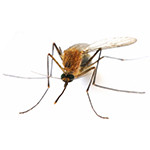 WHAT ARE MOSQUITOES?
WHAT ARE MOSQUITOES?
Mosquitoes feed on nectar like many other insects but female mosquitoes will also feed on the blood of humans and animals to assist with egg production. Female mosquitoes will use their mouthparts to puncture skin and inject saliva into the wound to prevent the blood from clotting. The discomfort, irritation and swelling from a mosquito bite is the result of the body’s immune response to this saliva. The blood meal taken by the female is used to supplement her diet with essential proteins and iron which she uses (along with carbohydrates derived from plant nectar) to assist in the development of her eggs. Mosquitoes in urban areas may lay eggs in ornamental ponds, rain gutters, bird baths, rain collection barrels, and other surfaces capable of holding water.
WHY DO I HAVE THEM?
Mosquitoes breed on or near standing water. This ultimately means that any source of standing water may become a breeding ground for mosquitoes. Because the female mosquito only requires a thin film of water in which to lay her eggs, tin cans, bird feeders, watering cans, old discarded tires, and clogged gutters may harbor these unpleasant pests. Mosquitoes are also known to travel as much as 20 miles in search of a blood meal, so it is safe to presume that they may also become problematic where no water source can be located.
ARE THEY DANGEROUS?
Mosquitoes are well known as transmitters of disease and illness to humans, domestic animals and wildlife as well as causing irritation, discomfort and frustration. In domestic animals, Canine Heartworm is also a huge concern for pet owners across the region. Protecting your family and pets from mosquitoes that spread disease requires a thoughtful, innovative approach to pest management.
HOW DO I GET RID OF MOSQUITOES?
Reducing the instances of mosquito bites and breeding areas can be an extremely frustrating task for any property owner. Treating the outside of the home, plus the interior by a professional is your best solution. If it’s not in the budget, here are a few DIY Tips to Mosquito Control.
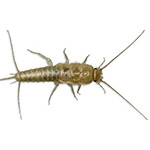 WHAT IS A SILVERFISH?
WHAT IS A SILVERFISH?
The silverfish is a small insect with a long, slender, flattened body measuring from ½ to 1 inch in length. From egg to adult takes about three to four months and the female silverfish can lay eggs at any point during the year.
WHY DO I HAVE THEM?
Silverfish like humid areas of moderate temperature and are especially fond of kitchen cupboards, basements, laundry rooms, attics, and under bathroom sinks. Dark places suit them well and they can often be found active at night or in dark places during the day. They do not hibernate so they can be active all year round.
ARE THEY DANGEROUS?
Silverfish are not associated with any disease so although not dangerous they can certainly be a nuisance and cause damage.
HOW DO I GET RID OF SILVERFISH?
Getting rid of silverfish can be a difficult task as they are generally nocturnal and can move about the entire property in search of food and a place to nest. A professional pest company is your best option.
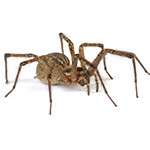 WHAT IS A SPIDER?
WHAT IS A SPIDER?
Maryland, DC and Northern Virginia are home to a variety of different species of spiders. The most notable spiders to be found in Baltimore, Washington DC, Alexandria, and throughout our region include wolf spiders, yellow sac spiders, and black widows.
WHY DO I HAVE THEM?
House Spiders are predatory insects that will move indoors, especially during the cooler months of the year, to find secure areas to build their webs. They primarily live outside in protected areas around windows and doors, or under eaves where light will attract prey. House spiders prefer to feed on small flies, mosquitoes and other invertebrate insects. Inside, you will find their webbing strung in garages, sheds, barns, warehouses, in corners and closets, under furniture, or along joints where the wall meets the ceiling.
ARE THEY DANGEROUS?
House spiders are not known to be an aggressive spider and although they can bite their venom is not always fatal to humans. They are more cause for frustration as a nuisance pest indoors because of their habit to abandon and rebuild webs.
HOW DO I GET RID OF SPIDERS?
House spiders are opportunistic pests that generally will only enter into your property if there is an easy means of doing so. You can help to control interior spider populations from the exterior by keeping shrubs and bushes trimmed away from the exterior of the property, as well as sealing any holes or cracks around doors, windows, and basements.
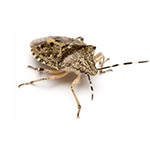 WHAT ARE STINK BUGS?
WHAT ARE STINK BUGS?
Stink bugs are easily recognizable because of the triangular shaped plate on their backs, which explains the common nickname “Shield bugs.” They are appropriately named because stink bugs have small glands located on their thorax that are capable of emitting an offensive odor. Stink bugs are usually different shades of brown and exist in the United States as well as in various parts of the world.
WHY DO I HAVE THEM?
Stink bugs are considered agricultural pests as well as nuisance pests. They may enter homes and businesses from cracks under or behind baseboards, around window and door trim and around exhaust fans or lights in ceilings in search for plants and fruit to feed on.
ARE THEY DANGEROUS?
Even though these stink bugs are not harmful to humans and do not reproduce inside structures such as houses, they cause concern when they become active in fall and spring. If many of them are squashed or vacuumed up, their smell can be quite apparent.
HOW DO I GET RID OF STINK BUGS?
Getting rid of stink bugs can be a difficult task as they are commonly found on both the interior and exterior of properties.
HOW CAN I PREVENT THIS IN THE FUTURE?
Adult stink bugs enter homes and other buildings in the fall, looking for a good spot to spend the winter. They can be mechanically excluded from homes and buildings by sealing cracks and other openings. Typical entry points include cracks and crevices around window and door trim, window-mounted air conditioners, exhaust fans, and chimneys. Cracks or other openings should be sealed with caulk to prevent entry by the adult stink bugs.
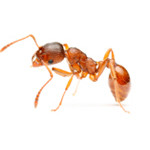 WHAT IS AN ANT?
WHAT IS AN ANT?
Ants are social insects. Ant colonies tend to form underground nests comprised of chambers and interconnecting tunnels. This is where ants store food, lay eggs and maintain nurseries. There can be tens of thousands of ants in a single colony.
WHY DO I HAVE THEM?
All ants share one primary task: to protect and care for the colony. This means they need food, moisture and shelter. A colony of ants may range from a few dozen to tens of thousands. Outside ant nests are under wood piles, flagstone or brick patios and under rocks and garden stones. Ants in the house may nest in wall voids, behind insulation, or in or around wood already damaged by moisture. You are most likely to find ants in the kitchen or invading your property elsewhere when they are foraging for food. The pheromone trail leads to and from the nest and provides direction for the ants to follow between the nest and food source. This is why you will often see ants like the odorous house ant, marching back and forth along one line with little or no deviation.
ARE THEY DANGEROUS?
In the Washington and Baltimore beltways most of the ant species dealt with fall into either one or two categories: nuisance pests or wood destroying insects (such as carpenter ants). Fire ants pose a series health threat in southern states as close as North Carolina and parts of Virginia.
HOW DO I GET RID OF ANTS?
Ants can be a particularly difficult pest to eradicate. Many home improvement stores sell ant traps and poison, but it should be used with caution as sometimes it can be harmful to household pets if ingested.
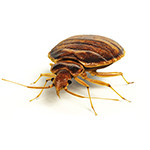 WHAT IS A BED BUG?
WHAT IS A BED BUG?
Bed bugs are small parasitic insects that are rising in number. Adult bed bugs have a distinct reddish-brown color and have flat, oval-shaped bodies about 1/4 inch in length. In a protected area, an adult female will lay up to five eggs in one day. The eggs are small, approximately 1mm in size and are whitish in color, making them almost invisible to the untrained eye. Signs that you have them are:
- Small spots of blood on mattresses and bed linens
- Tiny brown droppings
- Exoskeletons, or “cast skins” shed by growing nymphs
- Tiny white eggs and egg casings
WHY DO I HAVE THEM?
Bed bugs are efficient hitchhikers, capable of traveling great distances with an unsuspecting host. The affordability and prevalence of mass transit and international travel is a major contributing factor to the increase in bed bug infestations. It has become more common and more detrimental to travel to countries with less rigorous standards of hygiene and limited pest control practices. Because of this it is likely to find bed bugs in airplane seats, cabs and hotel beds. It is common for these pests to travel in luggage, backpacks and even in clothing. Once the bed bug has hitched a ride, its destination could be anywhere. Health care facilities, public transportation and private homes are just a few of the places you may seem them show up in.
ARE THEY DANGEROUS?
Bed bugs are not known to carry or spread diseases to humans, but their bites can cause skin irritation. Though many people have no reaction to bed bug bites, some experience small red welts. Bed bug bites often appear in a line or cluster and may be itchy or painful. Serious health problems can occur if the bites become infected. We recommend consulting a medical professional should this occur.
HOW DO I GET RID OF BED BUGS?
Bed bugs are hard to get rid of once an area of a home has become infested. They are nocturnal feeders which means they are rarely seen during the day. Their flat bodies make it easy for them to hide in cracks and crevices. They also hid inside mattresses and around button and seam lines, linens, behind baseboards and inside furniture. Many pest control companies provide EPA-approved bed bug control services. This includes K-9 detection, thermal remediation (heat treatments) and conventional liquid treatments.
From Orkin

Comments are closed.